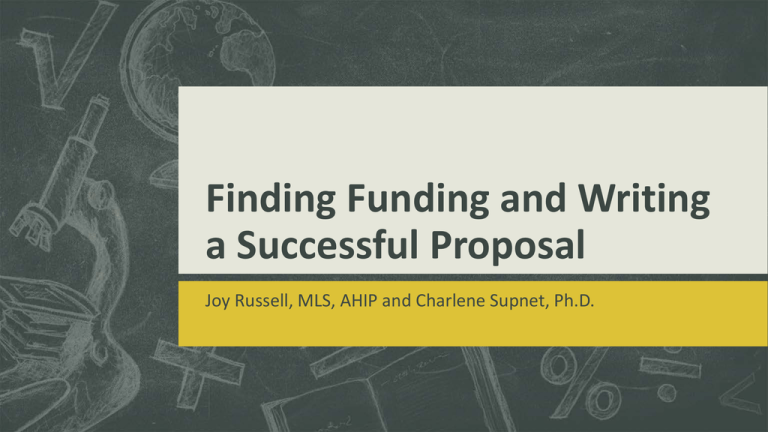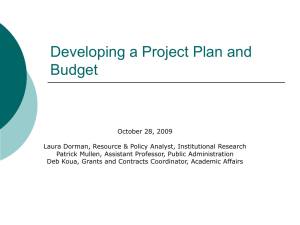Finding Funding and Writing a Successful Proposal
advertisement

Finding Funding and Writing a Successful Proposal Joy Russell, MLS, AHIP and Charlene Supnet, Ph.D. A Short Summary of Federal Grants What is a grant? A grant is a way the government funds your ideas and projects to provide public services and stimulate the economy. Grants support critical recovery initiatives, innovative research, and a litany of other programs. On Grants.gov you will find all the funding opportunities from the 26 federal agencies that award grants. Grant Funding Resources Grants.gov is designed to enable Federal grant-making agencies to create funding opportunities and applicants to find and apply for these Federal grants. The Grants.gov Online User Guide provides explanations and step-by-step instructions for both applicants and grantors to complete these processes. Grants.Gov - Navigation Home - The Grants.gov home page, which provides quick access to the latest funding opportunities, system updates, and other resources. Learn Grants - Links users to the Grants Learning Center (GLC), which provides grants lifecycle, policy, and other grants management-related information. Search Grants - Directs users to the Search page. Here, you can perform keyword or faceted search for funding opportunities. Using the Search Grants tab, grantors can confirm that their agency’s new or modified opportunities are successfully displayed. The screen default will display all open opportunities sorted by posted date in descending order. Applicants - Contains the applicant-specific functionality and resources within the Grants.gov website. The Applicants tab directs users to the Applicant Center, which lists the different Applicant Actions and Resources links depending on the user’s roles and login status. Grantors - Contains the functionality and resources for federal grant-making agencies and its users. The Grantors tab directs users to the Grantor Center, which lists different Grantor Actions and Resources links depending on the user’s roles and login status. Within the Grantors tab, users post grant opportunities, publish and retrieve grant applications, and access resources specifically for grant-making agencies. Stay Connected and Manage Subscriptions Grants.gov offers several ways to stay up to date with grant opportunities and system updates. Use the features that best serve your needs. Manage Subscriptions: The Manage Subscriptions link directs users to the Manage Subscriptions page to subscribe to RSS feeds or email notifications. User may also unsubscribe from this page. Email Notifications: Grants.gov is designed to allow users to register (i.e., subscribe) to receive email notifications of new grant postings that meet specific criteria. To register to receive grant postings that meet the needs of you or your organization, click the Manage Subscriptions link in the upper right corner of the Grants.gov banner. Once on the Manage Subscriptions page, there are several options to select from. You may also choose to unsubscribe from receiving email notifications on this page. Live Search: http://www.grants.gov/web/grants/home.html Grant Funding Resources …Continued National Institute of Health Department of Defense NIH Grant Writing Tips Sheets National Science Foundation Any Questions on Finding Funding? Writing a Successful Grant Proposal Charlene Supnet Department of Neurology and Neurotherapeutics Applying for Grant Funding IDEA • Novel • Exciting • Addresses a need • Well-developed FUNDING SOURCE GRANT WRITING • Federal, state • Foundations, societies • Talk to Joy • Research plan • Environment • Budget SUBMISSION • Meet all internal and sponsor requirements • Submit on time (early is better) • Sponsored Programs Administration Developing your idea Identify the problem/need • Will my idea address the problem? • Is the idea important to someone other than me? Research • Has this been done before? • Is there evidence to suggest that my idea will actually work? Hypothesis • A B, B C. Based on this data, my hypothesis is that A C • Is it testable? Layout of the research proposal (NIH, R) Project Summary Project Narrative Specific Aims Research Strategy • Significance • Innovation • Research Plan Project Summary • Should convey the broad, long-term objectives and specific aims • Brief description of research design • Background, gap in knowledge, problem, rationale for the study, central hypothesis, specific aims • Plain language, even a non-scientist should be able to understand the importance of the project • 30 line limit Project Narrative • For lay audience • Max 3 sentences long Specific Aims • Objectives of the project that will allow you to address your overall hypothesis • One page, the “make” or “break” page • After reading this page, the reviewer will already have preconceived notion of the quality of the proposal • Restate your Project Summary and expand on each Aim Specific Aims: General Structure Paragraph 1 : Background Paragraph 2: Gap in knowledge, problem Paragraph 3: Rationale for the study, central hypothesis Specific Aim 1. To determine…... Hypothesis: Rationale: Specific Aim 2. To determine….. Hypothesis: Rationale: Closing Paragraph: how the study will contribute to the science, future projects, how the project addresses the mission of the sponsor/foundation Specific Aims IMPORTANT: Your aims should be interconnected but not dependent on the successful outcome of another aim BAD: Aim 2 cannot proceed until the studies in Aim 1 are completed. GOOD: Aim 2 proceeds in parallel with Aim 1 and findings from Aim 1 might direct future studies in Aim 2 or 3. Each aim relates back to the overall hypothesis. Research Strategy Significance • • • Convey the importance of your project to the field How novel is it? How will this change treatment/diagnosis? How will it contribute to the gap in knowledge? Potential to contribute to future studies? About ¾ of a page Innovation • • Highlight the new techniques or approaches that you will use to address the problem About ¼ of a page Research Plan • • How you are going to do it About 5-11 pages Research Plan: General Structure Start with a summary paragraph of what you are proposing and why. Background – expand on Specific Aims page Preliminary studies – data that supports your line of thinking, feasibility Rationale for the study – expand on Specific Aims page, use diagrams Specific Aim 1. Verbatim what is written in the specific aims page. Specific Aim 2. Verbatim what is written in the specific aims page. Experimental Approach - Methods, interpretation of results, alternative hypotheses, timeline Putting it all together Top 10 Grant Writing Tips 1. Convey enthusiasm!! 2. Be mindful of your audience 3. W5H 4. Active voice "Why did the chicken cross the road?" instead of "Why was the road crossed by the chicken?" 5. Jargon – explain what acronyms and science specific mean Top 10 Grant Writing Tips 6. Ensure that you are responding to the specifics of the request for application (RFA) or funding opportunity announcement (FOA). 7. There is no need to pepper otherwise clear prose with unnecessary jargon and repetitive, clutter-inducing sesquipedalian verbiage. Say what you mean, clearly and concisely 8. To be convincing give examples to support your statements. Use citations. 9-10. Review, review, review!!! Thank You! Any questions? Joy Russell, MLS, AHIP Systematic Review and Grants Education Librarian 214.648.1232 Joy.Russell@UTSouthwestern.edu http://grantfundingresources.wor dpress.com Charlene Supnet, Ph.D. Director, Neuroscience Research Development (NeRD) Office Assistant Professor, Department of Neurology and Neurotherapeutics 214-648-6091 charlene.supnet@utsouthwestern.edu Please don’t forget to sign-in for an electronic copy of this presentation and access to the links.




